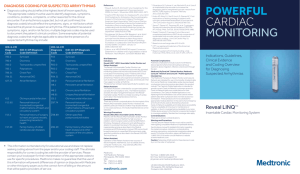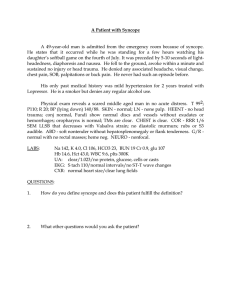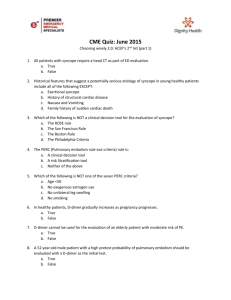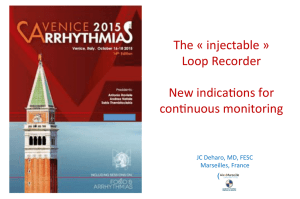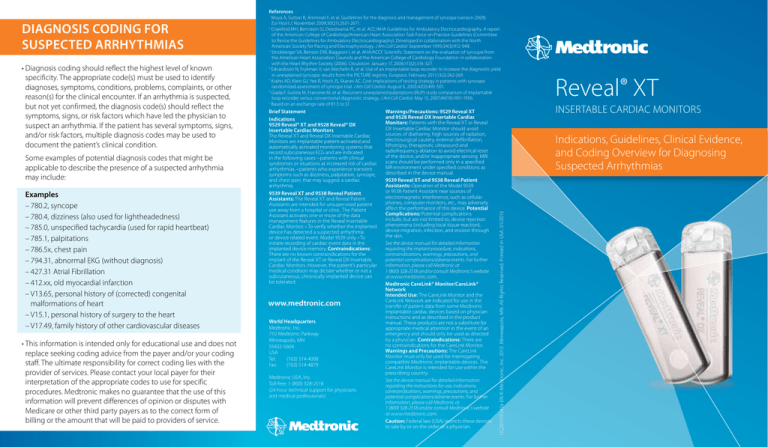
•Diagnosis coding should reflect the highest level of known
specificity. The appropriate code(s) must be used to identify
diagnoses, symptoms, conditions, problems, complaints, or other
reason(s) for the clinical encounter. If an arrhythmia is suspected,
but not yet confirmed, the diagnosis code(s) should reflect the
symptoms, signs, or risk factors which have led the physician to
suspect an arrhythmia. If the patient has several symptoms, signs,
and/or risk factors, multiple diagnosis codes may be used to
document the patient’s clinical condition.
Some examples of potential diagnosis codes that might be
applicable to describe the presence of a suspected arrhythmia
may include:
Examples
–780.2, syncope
–780.4, dizziness (also used for lightheadedness)
–785.0, unspecified tachycardia (used for rapid heartbeat)
–785.1, palpitations
–786.5x, chest pain
–794.31, abnormal EKG (without diagnosis)
–427.31 Atrial Fibrillation
–412.xx, old myocardial infarction
–V13.65, personal history of (corrected) congenital
malformations of heart
–V15.1, personal history of surgery to the heart
–V17.49, family history of other cardiovascular diseases
•This information is intended only for educational use and does not
replace seeking coding advice from the payer and/or your coding
staff. The ultimate responsibility for correct coding lies with the
provider of services. Please contact your local payer for their
interpretation of the appropriate codes to use for specific
procedures. Medtronic makes no guarantee that the use of this
information will prevent differences of opinion or disputes with
Medicare or other third party payers as to the correct form of
billing or the amount that will be paid to providers of service.
Brief Statement
Indications
9529 Reveal® XT and 9528 Reveal® DX
Insertable Cardiac Monitors
The Reveal XT and Reveal DX Insertable Cardiac
Monitors are implantable patient-activated and
automatically activated monitoring systems that
record subcutaneous ECG and are indicated
in the following cases: • patients with clinical
syndromes or situations at increased risk of cardiac
arrhythmias. • patients who experience transient
symptoms such as dizziness, palpitation, syncope,
and chest pain, that may suggest a cardiac
arrhythmia.
9539 Reveal XT and 9538 Reveal Patient
Assistants: The Reveal XT and Reveal Patient
Assistants are intended for unsupervised patient
use away from a hospital or clinic. The Patient
Assistant activates one or more of the data
management features in the Reveal Insertable
Cardiac Monitor: • To verify whether the implanted
device has detected a suspected arrhythmia
or device related event. Model 9539 only. • To
initiate recording of cardiac event data in the
implanted device memory. Contraindications:
There are no known contraindications for the
implant of the Reveal XT or Reveal DX Insertable
Cardiac Monitors. However, the patient’s particular
medical condition may dictate whether or not a
subcutaneous, chronically implanted device can
be tolerated.
www.medtronic.com
World Headquarters
Medtronic, Inc.
710 Medtronic Parkway
Minneapolis, MN 55432-5604
USA
Tel:
(763) 514-4000
Fax:
(763) 514-4879
Medtronic USA, Inc.
Toll-free: 1 (800) 328-2518
(24-hour technical support for physicians
and medical professionals)
Warnings/Precautions: 9529 Reveal XT
and 9528 Reveal DX Insertable Cardiac
Monitors: Patients with the Reveal XT or Reveal
DX Insertable Cardiac Monitor should avoid
sources of diathermy, high sources of radiation,
electrosurgical cautery, external defibrillation,
lithotripsy, therapeutic ultrasound and
radiofrequency ablation to avoid electrical reset
of the device, and/or inappropriate sensing. MRI
scans should be performed only in a specified
MR environment under specified conditions as
described in the device manual.
9539 Reveal XT and 9538 Reveal Patient
Assistants: Operation of the Model 9539
or 9538 Patient Assistant near sources of
electromagnetic interference, such as cellular
phones, computer monitors, etc., may adversely
affect the performance of this device. Potential
Complications: Potential complications
include, but are not limited to, device rejection
phenomena (including local tissue reaction),
device migration, infection, and erosion through
the skin.
See the device manual for detailed information
regarding the implant procedure, indications,
contraindications, warnings, precautions, and
potential complications/adverse events. For further
information, please call Medtronic at
1 (800) 328-2518 and/or consult Medtronic’s website
at www.medtronic.com.
Medtronic CareLink® Monitor/CareLink®
Network
Intended Use: The CareLink Monitor and the
CareLink Network are indicated for use in the
transfer of patient data from some Medtronic
implantable cardiac devices based on physician
instructions and as described in the product
manual. These products are not a substitute for
appropriate medical attention in the event of an
emergency and should only be used as directed
by a physician. Contraindications: There are
no contraindications for the CareLink Monitor.
Warnings and Precautions: The CareLink
Monitor must only be used for interrogating
compatible Medtronic implantable devices. The
CareLink Monitor is intended for use within the
prescribing country.
See the device manual for detailed information
regarding the instructions for use, indications,
contraindications, warnings, precautions, and
potential complications/adverse events. For further
information, please call Medtronic at
1 (800) 328-2518 and/or consult Medtronic’s website
at www.medtronic.com.
Caution: Federal law (USA) restricts these devices
to sale by or on the order of a physician.
Reveal® XT
InserTable Cardiac Monitors
Indications, Guidelines, Clinical Evidence, and Coding Overview for Diagnosing
Suspected Arrhythmias
UC201105542a EN © Medtronic, Inc. 2013. Minneapolis, MN. All Rights Reserved. Printed in USA. 01/2013
Diagnosis Coding for
Suspected Arrhythmias
References
1
Moya A, Sutton R, Ammirati F, et al. Guidelines for the diagnosis and management of syncope (version 2009). Eur Heart J. November 2009;30(21):2631-2671.
2
Crawford MH, Bernstein SJ, Deedwania PC, et al. ACC/AHA Guidelines for Ambulatory Electrocardiography. A report
of the American College of Cardiology/American Heart Association Task Force on Practice Guidelines (Committee
to Revise the Guidelines for Ambulatory Electrocardiography). Developed in collaboration with the North
American Society for Pacing and Electrophysiology. J Am Coll Cardiol. September 1999;34(3):912-948.
3
Strickberger SA, Benson DW, Biaggioni I, et al. AHA/ACCF Scientific Statement on the evaluation of syncope from
the American Heart Association Councils and the American College of Cardiology Foundation: in collaboration
with the Heart Rhythm Society (2006). Circulation. January 17, 2006;113(2):316-327.
4
Edvardsson N, Frykman V, van Mechelin R, et al. Use of an implantable loop recorder to increase the diagnostic yield
in unexplained syncope: results from the PICTURE registry. Europace. February 2011;13(2):262-269.
5
Krahn AD, Klein GJ, Yee R, Hoch JS, Skanes AC. Cost implications of testing strategy in patients with syncope:
randomized assessment of syncope trial. J Am Coll Cardiol. August 6, 2003;42(3):495-501.
6
Giada F, Gulizia M, Francese M, et al. Recurrent unexplained palpitations (RUP) study comparison of implantable
loop recorder versus conventional diagnostic strategy. J Am Coll Cardiol. May 15, 2007;49(19):1951-1956.
7
Based on an exchange rate of €1.5 to $1.
Reveal® XT ICMs
Indications
Recurrent Unexplained Palpitations (RUP) Study6
The Reveal XT Insertable Cardiac Monitor (ICM) is an implantable
patient-activated and automatically activated monitoring system
that records subcutaneous ECG and has been cleared by the FDA
for use in two groups of patients:
Newer insertable cardiac monitors can be implanted under the skin for long-term recordings, which may be particularly useful for
patients with infrequent symptoms.2,3
•patients with clinical syndromes or situations at increased risk of
cardiac arrhythmias
AHA/ACC Scientific Statement on the Evaluation of
Syncope3
•patients who experience transient symptoms such as dizziness,
palpitation, syncope, and chest pain that may suggest a cardiac
arrhythmia
“This approach (ILRs) is more likely to identify the mechanism of syncope than is a conventional approach that uses Holter
or event monitors and EP testing, and is cost-effective.”
Reveal XT ICMs
Reveal XT ICMs
Reveal XT ICMs
Guidelines
Clinical Evidence
Reveal-related procedure coding
ESC Guidelines: Diagnosis and Management
of Syncope (2009)1
Procedure coding for physician and outpatient
hospital services
Class I
Place of Reveal in the Care Pathway and Treatment of
Patients with Unexplained Recurrent Syncope (PICTURE)
Study4
Insertable Loop Recorder (ILR) (insertable cardiac monitor) is
indicated in:
In 570 patients implanted with a Reveal ICM and followed
for a year:
• An early phase of evaluation in patients with recurrent syncope of
uncertain origin, absence of high risk criteria, and a high likelihood
of recurrence within battery longevity of the device
• High risk patients in whom a comprehensive evaluation did not
demonstrate a cause of syncope or lead to a specific treatment
ACC/AHA Guidelines: Indications for Ambulatory
Electrocardiography2
Class I
Conditions for which there is evidence and/or general agreement
that a given procedure or treatment is useful and effective.
• Patients with unexplained syncope, near syncope, or episodic
dizziness in whom the cause is not obvious
• Patients with unexplained recurring palpitations
•50 patients with infrequent sustained palpitations were randomized
either to a conventional external monitoring strategy or to a Reveal ILR
•Diagnosis was obtained in 21% of the conventional group and 73%
of the ILR group, with significantly lower cost per diagnosis in the
ILR group ($4,584 vs. $10,152)7
CPT®8Description
33282
Implant pat-active ht record (ILR)
33284
Remove pat-active ht record (ILR)
•Overall, patients had seen an average of three different specialists for
management of their syncope
93285
ILR device eval/programming
93291
ILR device interrogation (in person)
•The median number of tests performed per patient in the total study
population was 13 (inter-quartile range 9 – 20)
93298
ILR device interrogation (remote, prof svc)
93299
ILR device interrogation (remote, tech svc)
•Most patients (70%) had been hospitalized at least once for syncope
– one third (36%) of these patients had experienced
significant trauma in association with a syncopal episode
Randomized Assessment of Syncope Trial (RAST)5
•60 unexplained syncope patients randomized to conventional testing
or a Reveal ILR
•The diagnostic yield was 43% for ILR vs. 20% for conventional, and the
cost/diagnosis of ILR was 26% less than conventional testing
C code required for Medicare hospital OP services
C1764
Event recorder, cardiac (implantable)
Procedure coding for inpatient hospital services
37.79
Revision or relocation of cardiac device pocket (includes
ILR implant)
86.05
Incision with removal of foreign body or device from skin
and subcutaneous tissue (includes ILR explant)

